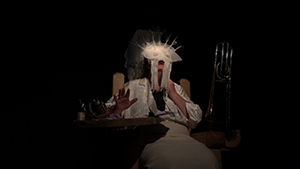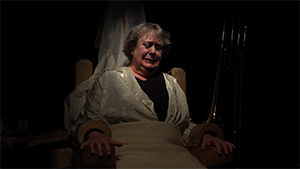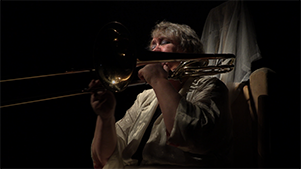The Chair, Part II of the Miriam Trilogy
(A music theater work for performance-artist and pianist.)
Table of Contents
1. A Brief Descrption of Miriam and the Materials On This Site
3. The Video of the Chair (Miriam Part II)
4. A 12 minute demo video of the entire Miriam Trilogy and it rushes
![]()
1. Brief Description of Miriam and the Materials on This Site.
 A music theater trilogy for soprano (with optional instrumental part) and piano on a text by the composer. The three parts are entitled
The
Mirror, The Chair, and
The River. (80 minutes.) Premiere of the The Chair: Stuttgart – Tage der Neue Musik (1988) Premiere of the complete triology: Munich Biennale, May 1990.
A music theater trilogy for soprano (with optional instrumental part) and piano on a text by the composer. The three parts are entitled
The
Mirror, The Chair, and
The River. (80 minutes.) Premiere of the The Chair: Stuttgart – Tage der Neue Musik (1988) Premiere of the complete triology: Munich Biennale, May 1990.
In Part I, The Mirror, a woman trapped in a domestic role moves toward a nervous breakdown. In Part II, The Chair, she is Institutionalized, where she attempts to create a performance for a shortly expected visit from her children, but can find no words to express her feelings. She discovers she has no language of her own and recedes more and more into silence. Only her instrument can serve as an expression of her deepest emotions. In Part III, The River, Miriam sits at a rivers edge as if floating her child away in the waters.
![]()
2. PDF Score and Text
You can download the score and text of Miriam Parts II, The Chair, by clicking on the links below. The score uses "Concert" size paper which is 12X9 inches in landscap format. Print the score on Tabloid (USA) or A3 (EU) size paper and trim it to size. I will continue to correct the score, so check back for the latest version.
Score:
The Chair Part II of the Miriam Trilogy) Concert size paper (9x12 inches) corrected December 13, 2018.
Text:
Text of Miriam Part II, The Chair
![]()
3. Complete Video of The Chair
Abbie Conant, performer
Roberta Militello, masks
William Osborne, music, text, direction, video
Filmed in our Taos studio in 2020.
A short excerpt from The Chair. She plays her instrument
![]()
4. A Twelve Minute Demo Video of clips from the Entire Miriam Trilogy.
Filmed at the Hamburg State Opera in 1990
Abbie Conant, performance-artist
Leonore Hall, piano
Roberta Militello, masks
William Osborne, music, text, direction, video
Below are the rushes we made in 1990 at the Hamburg State Opera for a demo video of our music theater work Miriam. They were made when I was 35 and we were at the height of our abilities. The work is obviously high quality, but we became even more ostracized because Miriam was a response to the egregious sexism I faced in the Munich Philharmonic and stepped on way too many toes. Three years later, in 1993, we performed Miriam at the first International Women's Brass Conference. The ecstatic reaction made us realize we had found a new world. It was 30 years, however, before we could use our own resources and new consumer technology to make a full video of Miriam.
![]()
5. The page for Part I of the Miriam Trilogy, The MIrror, is here.
It includes a video of The Mirror, and a video of a stand-alone trombone work excerted from it entitled Lament.
![]()
6. A Slide Show
To download the higher rez photos below, click the thumbnails. You might need to resize your screen to see the whole photo. After viewing and possibly saving, use your browser's back arror to return.
 |
 |
 |
 |
 |
 |
 |
 |
 |
 |
 |
7. Program Notes
 Miriam explores the relation between language, creativity, and identity. We develop the premise that the pursuit of creative identity is fundamental to human dignity, and that people denied that freedom develop existential, spiritual, and psychological problem
Miriam explores the relation between language, creativity, and identity. We develop the premise that the pursuit of creative identity is fundamental to human dignity, and that people denied that freedom develop existential, spiritual, and psychological problem
Miriam also
explores the belief that humanity has repressed its feminine side, thus losing many icons, archetypes, and forms of communication necessary for its well-being.
Women confront these issues because society imposes roles upon them that limit their human potential. Miriam’s domestic role forces her to wear "masks," but her buried authenticity fights back. Women in the workplace face similar pressures since they often confront attitudes and prejudice that limit their development. These were the experiences of Abbie Conant who
fought egregious discrimination in the Munich Philharmonic for 13 years.
Many professional women identify with Miriam. Sylvia Alimena, conductor of the Eclipse Chamber Orchestra in Washington, D.C. and a horn player with the National Symphony, was quoted in a feature about Abbie and Miriam in the Washington Post:
 “‘You can not imagine the power of this piece unless you were there in the room, Alimena says. “All those professional women, just shaken to their cores by this piece. Of course it resonates particularly with other players, because -believe it- the kind of treatment Abbie went through in Munich is not, by any stretch of the imagination, unknown in the United States.’”
“‘You can not imagine the power of this piece unless you were there in the room, Alimena says. “All those professional women, just shaken to their cores by this piece. Of course it resonates particularly with other players, because -believe it- the kind of treatment Abbie went through in Munich is not, by any stretch of the imagination, unknown in the United States.’”
Miriam experiences internal crisis, but she is more than just another “mad woman of opera,” since she consciously confronts the stereo-typed roles, masks, and personas that are forced upon her as a woman. Perhaps this passage from A Spy in the House of Love by Anais Nin best describes the conflict of Miriam:
“She was like an actress who must compose a face, an attitude to meet the day. . . She must redesign the face, smooth the anxious brows, separate the crushed eye-lashes, wash off the traces of secret, interior tears, accentuate the mouth as upon a canvas, so it will hold its luxuriant smile. Inner chaos, like those secret volcanoes which suddenly lift the neat furrows of a peacefully plowed field, awaited behind all disorders of face, hair and costume, for a fissure through which to explode."
“Unfortunately, Abbie's story reflects the rule,” notes Monique Buzzarte in the IAWM Journal, “not the exception, for women trombonists. Her case is distinguished from so many others not by the actions she endured, but by their severity, her documentation of them, and most notably, by her eventual victory.”